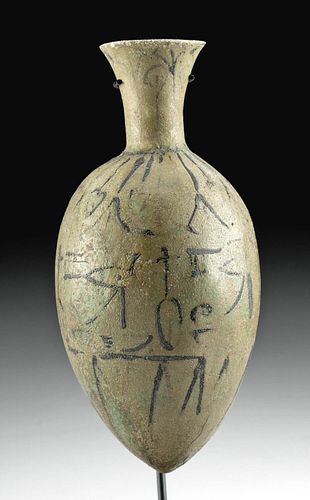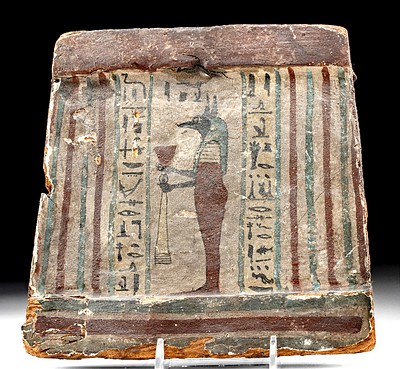Rare Egyptian Amarna Faience Lotus Bottle w/ Glyphs
Lot 3
About Seller
Artemis Fine Arts
686 S Taylor Ave, Ste 106
Louisville, CO 80027
United States
Selling antiquities, ancient and ethnographic art online since 1993, Artemis Gallery specializes in Classical Antiquities (Egyptian, Greek, Roman, Near Eastern), Asian, Pre-Columbian, African / Tribal / Oceanographic art. Our extensive inventory includes pottery, stone, metal, wood, glass and textil...Read more
Categories
Estimate:
$12,000 - $18,000
Absentee vs Live bid
Two ways to bid:
- Leave a max absentee bid and the platform will bid on your behalf up to your maximum bid during the live auction.
- Bid live during the auction and your bids will be submitted real-time to the auctioneer.
Bid Increments
| Price | Bid Increment |
|---|---|
| $0 | $25 |
| $300 | $50 |
| $1,000 | $100 |
| $2,000 | $250 |
| $5,000 | $500 |
| $10,000 | $1,000 |
| $20,000 | $2,500 |
| $50,000 | $5,000 |
| $100,000 | $10,000 |
| $200,000 | $20,000 |
About Auction
By Artemis Fine Arts
Aug 26, 2021
Set Reminder
2021-08-26 10:00:00
2021-08-26 10:00:00
America/New_York
Bidsquare
Bidsquare : Fine Antiquities | Asian | Ethnographic Art
https://www.bidsquare.com/auctions/artemis-gallery/fine-antiquities-asian-ethnographic-art-7366
Features classical antiquities, ancient and ethnographic art from cultures encompassing the globe. Egyptian, Greek, Roman, Etruscan, Near Eastern, Asian, Pre-Columbian, Native American, African / Tribal, Oceanic, Spanish Colonial, Russian, Fine / Visual Arts, so much more! Artemis Fine Arts info@artemisgallery.com
Features classical antiquities, ancient and ethnographic art from cultures encompassing the globe. Egyptian, Greek, Roman, Etruscan, Near Eastern, Asian, Pre-Columbian, Native American, African / Tribal, Oceanic, Spanish Colonial, Russian, Fine / Visual Arts, so much more! Artemis Fine Arts info@artemisgallery.com
- Lot Description
Ancient Egypt, New Kingdom, late 18th Dynasty, Amarna Period, reign of Akhenaten (formally Amenhotep IV), ca. 1353 to 1336 BCE. An incredible, mold-formed faience vessel known as a lotus bottle covered in softened layers of turquoise-hued glaze and embellished with ample iconography. Presenting with a dignified form, the piriform body exhibits a conical base, rounded walls that gradually transition upwards to a sloped shoulder, and a narrow cylindrical neck surmounted by a flared rim. Surrounding the neck is a register of lotus blossoms and water lilies with the shoulder bearing similar but inverted imagery, and the base is encircled with blooming lotus petals. A register of repeating hieroglyphs encompassing the midsection include wadjet (also wedjat or Eye of Horus), heart-and-windpipes, and semicircular bowls or baskets below. When viewed together, the hieroglyphs suggest that this vessel was a votive offering meant as a means of protection for both the heart and voice of the deceased as they recited their negative confession and endured the final trial on their journey to the afterlife: the ceremony known as the 'weighing of the heart.' The bowls or baskets represented gifts of sustenance for the deceased on their journey, and the ample lotus imagery was symbolic as a means of rebirth for the deceased's soul. An outstanding example of Amarna-period artistry! Size: 2.7" Diameter x 5.625" H (6.9 cm x 14.3 cm); 7.6" H (19.3 cm) on included custom stand.
Cf. Friedman, Florence Dunn, ed. "Gifts of the Nile: Ancient Egyptian Faience." Thames & Hudson in association with the Museum of Art, Rhode Island School of Design, 1998, p. 119.
Another example hammered for $23,900 at Christie's, New York "Antiquities" auction (sale 1314, December 11, 2003, lot 40)
This piece has been tested using thermoluminescence (TL) analysis and has been found to be ancient and of the period stated. A full report will accompany purchase.
Provenance: private Corpus Christi, Texas, USA estate collection, acquired 1960s to 1970s; acquisition number penned inside of bottle indicates originally acquired around 1939
All items legal to buy/sell under U.S. Statute covering cultural patrimony Code 2600, CHAPTER 14, and are guaranteed to be as described or your money back.
A Certificate of Authenticity will accompany all winning bids.
PLEASE NOTE: Due to recent increases of shipments being seized by Australian & German customs (even for items with pre-UNESCO provenance), we will no longer ship most antiquities and ancient Chinese art to Australia & Germany. For categories of items that are acceptable to ship to Australia or Germany, please contact us directly or work with your local customs brokerage firm.
Display stands not described as included/custom in the item description are for photography purposes only and will not be included with the item upon shipping.
#165076Petite nicks to rim, body, and base, with abrasions and fading to glaze pigment and bitumen hieroglyphs, light encrustations, and a couple of stable hairline fissures on body, otherwise intact and excellent. Great remains of glaze pigment in a few areas, nice preservation to hieroglyphs, and overall fantastic form. Old acquisition number written on inside of rim. TL drill holes beneath base and along rim.Condition
- Shipping Info
-
All shipping is handled in-house for your convenience. Your invoice from Artemis Gallery will include shipping calculation instructions. If in doubt, please inquire BEFORE bidding for estimated shipping costs for individual items.
-
- Buyer's Premium



 EUR
EUR CAD
CAD AUD
AUD GBP
GBP MXN
MXN HKD
HKD CNY
CNY MYR
MYR SEK
SEK SGD
SGD CHF
CHF THB
THB















